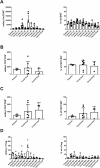Antigen-specific immunotherapy combined with a regenerative drug in the treatment of experimental type 1 diabetes
- PMID: 33144616
- PMCID: PMC7609712
- DOI: 10.1038/s41598-020-76041-1
Antigen-specific immunotherapy combined with a regenerative drug in the treatment of experimental type 1 diabetes
Abstract
Type 1 diabetes is an autoimmune disease caused by the destruction of the insulin-producing β-cells. To revert type 1 diabetes, the suppression of the autoimmune attack should be combined with a β-cell replacement strategy. It has been previously demonstrated that liraglutide, a glucagon-like peptide-1 receptor agonist, restores β-cell mass in type 1 diabetes, via α-cell transdifferentiation and neogenesis. We report here that treatment with liraglutide does not prevent type 1 diabetes in the spontaneous non-obese diabetic (NOD) mouse model, but it tends to reduce leukocytic islet infiltration. However, in combination with an immunotherapy based on tolerogenic liposomes, it is effective in ameliorating hyperglycaemia in diabetic NOD mice. Importantly, liraglutide is not detrimental for the tolerogenic effect that liposomes exert on dendritic cells from patients with type 1 diabetes in terms of membrane expression of molecules involved in antigen presentation, immunoregulation and activation. Moreover, the in vivo effect of the combined therapy was tested in mice humanised with peripheral blood mononuclear cells from patients with type 1 diabetes, showing no adverse effects in leukocyte subsets. In conclusion, the combination therapy with liraglutide and a liposome-based immunotherapy is a promising candidate strategy for type 1 diabetes.
Conflict of interest statement
M.C.-S., D.M., and M.V.-P. are co-founders of Ahead Therapeutics S.L., which aims at the clinical translation of immunotherapies for the treatment of autoimmune diseases. S.R.-F. is part-time employed at Ahead Therapeutics S.L. All other authors have no competing interest.
Figures





Similar articles
-
Repurposed Analog of GLP-1 Ameliorates Hyperglycemia in Type 1 Diabetic Mice Through Pancreatic Cell Reprogramming.Front Endocrinol (Lausanne). 2020 May 13;11:258. doi: 10.3389/fendo.2020.00258. eCollection 2020. Front Endocrinol (Lausanne). 2020. PMID: 32477262 Free PMC article.
-
Anti-IL-21 monoclonal antibody combined with liraglutide effectively reverses established hyperglycemia in mouse models of type 1 diabetes.J Autoimmun. 2017 Nov;84:65-74. doi: 10.1016/j.jaut.2017.07.006. Epub 2017 Jul 12. J Autoimmun. 2017. PMID: 28711285
-
Liraglutide and sitagliptin counter beta- to alpha-cell transdifferentiation in diabetes.J Endocrinol. 2020 Apr;245(1):53-64. doi: 10.1530/JOE-19-0451. J Endocrinol. 2020. PMID: 31977315
-
Type I diabetes mellitus: a predictable autoimmune disease with interindividual variation in the rate of beta cell destruction.Clin Immunol Immunopathol. 1989 Jan;50(1 Pt 2):S85-95. doi: 10.1016/0090-1229(89)90115-3. Clin Immunol Immunopathol. 1989. PMID: 2642771 Review.
-
Customized cell-based treatment options to combat autoimmunity and restore beta-cell function in type 1 diabetes mellitus: current protocols and future perspectives.Adv Exp Med Biol. 2010;654:641-65. doi: 10.1007/978-90-481-3271-3_28. Adv Exp Med Biol. 2010. PMID: 20217518 Review.
Cited by
-
Nanomaterials for antigen-specific immune tolerance therapy.Drug Deliv Transl Res. 2023 Jul;13(7):1859-1881. doi: 10.1007/s13346-022-01233-3. Epub 2022 Sep 12. Drug Deliv Transl Res. 2023. PMID: 36094655 Review.
-
Exploration of Immune Targets for Type 1 Diabetes and Latent Autoimmune Disease Immunotherapy.Immunotargets Ther. 2023 Sep 29;12:91-103. doi: 10.2147/ITT.S417917. eCollection 2023. Immunotargets Ther. 2023. PMID: 37795196 Free PMC article. Review.
-
Particle-Based therapies for antigen specific treatment of type 1 diabetes.Int J Pharm. 2023 Jan 25;631:122500. doi: 10.1016/j.ijpharm.2022.122500. Epub 2022 Dec 15. Int J Pharm. 2023. PMID: 36529362 Free PMC article. Review.
-
Delivery route considerations for designing antigen-specific biomaterial strategies to combat autoimmunity.Adv Nanobiomed Res. 2023 Mar;3(3):2200135. doi: 10.1002/anbr.202200135. Epub 2023 Jan 29. Adv Nanobiomed Res. 2023. PMID: 36938103 Free PMC article.
References
-
- Landin-Olsson M, Erlanson-Albertsson C. Immunotherapy for Type 1 diabetes: Past and future. Diabetes Manag. 2012;2:139–147. doi: 10.2217/dmt.12.3. - DOI
Publication types
MeSH terms
Substances
LinkOut - more resources
Full Text Sources
Medical
Molecular Biology Databases

